How to Write Flash Fiction: A Guide to Writing Impactful, Compact Stories
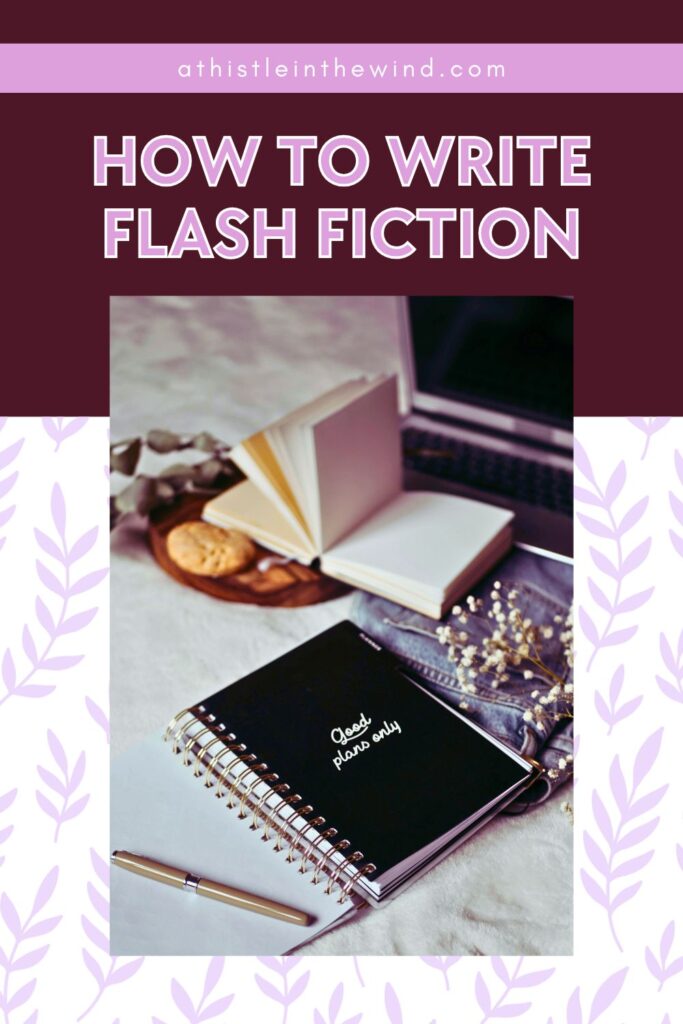
I’ve started submitting some prose to literary magazines recently and as usual, I kept running into the same problem: the word count. In my guide on how to write a short story, I talked about how to structure and write a short story. I also briefly mentioned flash fiction, as a type of a short story.
And well, this is the blog about it. We’re going to talk about flash fiction, and how you can write it. It’s super popular with most indie literary magazines and if you’re an up-and-coming writer, it’s a great way to start fine-tuning your writing and building your portfolio.
So, let’s get started!
What Exactly Is Flash Fiction?
Dictionary.com says that flash fictions are “very short works of fiction that are typically no longer than a couple of pages and may be as short as one paragraph.”
At its core, a flash fiction is any fictional story that delivers a complete narrative with its own plot, characters, and setting in a tight word count. While some might consider anything under 1,500 words to be flash fiction, many pieces are far shorter, often aiming for under 1,000 words, and frequently even under 500 words.
More Than Just “Short”
It’s critical to understand that flash fiction is much more than just a short story. It’s meant to be a moment in time, an episode of a series, or even a “story starter” that offers a glimpse or a surprise rather than tying up every loose end.
Despite the brevity, a flash fic needs to still encompass all the elements of a story. It needs a beginning, a middle, and an end, and a character should experience some form of growth, even if it’s a small step, a single decision, a sudden realisation, or a moment of truth.
Flash fiction isn’t merely a vignette or a prose poem, though it can adopt elements from both. It can be a hybrid form, a script dialogue, a fragmented puzzle, or even a song lyric, but the non-negotiable requirement is that there must be a story.
It can be quiet or momentous, heartbreaking or hilarious, political or poignant, but it always has a narrative arc. Sometimes this arc is very obvious, other times it’s implied, found in between lines or beneath complex layers.
The Word Count Spectrum
The genre of flash fiction is very diverse, with various sub-categories based on word count. While these aren’t rigid rules, they offer a useful guide for writers and publishers:
- The Six Word Story: As the name suggests, precisely six words.
- Twitterature: Stories constrained to under 280 characters.
- Minisaga (or dribble): Under 50 words.
- Microfiction (or drabble): Under 100 words.
- Sudden fiction: Under 750 words.
- Flash fiction: Generally understood as under 1,500 words, often with common submission limits of 1,000 or 500 words.
Regardless of the specific word count, the goal remains the same: to deliver a complete story that feels finished and complex enough to linger in the reader’s mind.
Why Should You Write Flash Fiction?
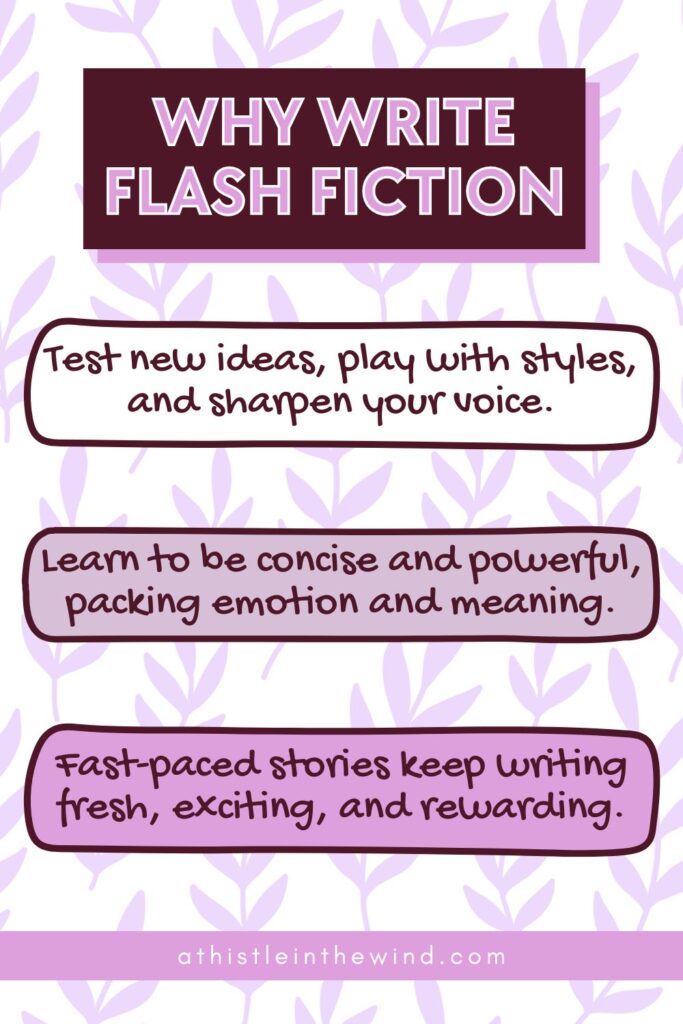
If you’re a new writer, flash fiction can seem incredibly challenging. You have to pack so much into so few words. And it can lead to pieces that are too ambitious, overloaded with characters, or lack a clear central focus. That’s not all either; you need to focus on your writing style too. The language must be beautiful, the plot complete—the whole piece must feel cohesive.
It can be overwhelming but that’s what makes flash fiction a fantastic playground. It’s an excellent way to experiment with new story ideas, try out different styles, and become a more concise and impactful writer without having to commit a lot of time to a longer project.
Many writers find the process refreshing and enjoyable, discovering that these short bursts of creativity just flow out, somehow making sense and forming a coherent narrative. It’s also known as the fastest, most fun way to develop your writing.
The appeal lies in its quickness, its suddenness, the sheer punch an author can pack into its brevity. It’s about creating something memorable, something that catches you and holds you, echoing and resonating long after the final word.
The Core Elements of a Flash Story
Every compelling story, regardless of its length, relies on certain foundational elements. In flash fiction, these elements become even more crucial because every word must earn its place.
1. Every Story Needs a Heartbeat
At its essence, flash fiction is a story. It needs a narrative arc, a journey, however small, that your character undertakes. This arc might be starkly obvious or deeply subtle, requiring the reader to search for it between the lines or in implied endings. But rest assured, in powerful flash fiction, the heartbeat of a story is always there.
To achieve this, the first thing you must do when writing flash is trust the reader. Trust them to fill in the gaps, to seek out that narrative arc. You can write with extreme brevity, stripping your story down to its very bones, and readers will indeed “get it.” This trust frees you to play, experiment, and weave your stories onto the page in all sorts of unusual and impactful ways.
2. Remember: Conflict is King
Just like in longer works, conflict is the engine that drives flash fiction. Without conflict—be it external (character vs. character, society, or nature) or internal (a struggle within the character’s mind)—there is no story.
Your flash piece absolutely must include conflict.
When you begin to draft, try to start your story at the very point of conflict, or even just a moment after the conflict has begun.
This approach immediately imbues your story with urgency. This urgency doesn’t necessarily mean a fast-paced narrative; rather, it’s the need to tell the story that creates the urgency.
You can certainly tell a flash story quietly, with nuance, varying tension, pace, and rhythm. In fact, it’s often more effective to allow the reader to pause and absorb moments within the narrative.
3. The “Uff” Factor
Even in a story as short as 100 words, you should strive for an emotional connection. Your story should deliver a punch, making the reader laugh, cry, or feel deeply moved without ever resorting to being preachy or clichéd.
Before you even start writing, ask yourself: What story do I want to tell? And how do I want to make my reader feel? These two questions will give you a clear picture of your plot and tone.
Then, the real challenge begins: How will you achieve that emotional impact in such a confined space? The goal, as one expert puts it, is for the story to be like a firework: a sudden burst of brilliance that, even after it’s over, leaves an indelible image imprinted on your mind.
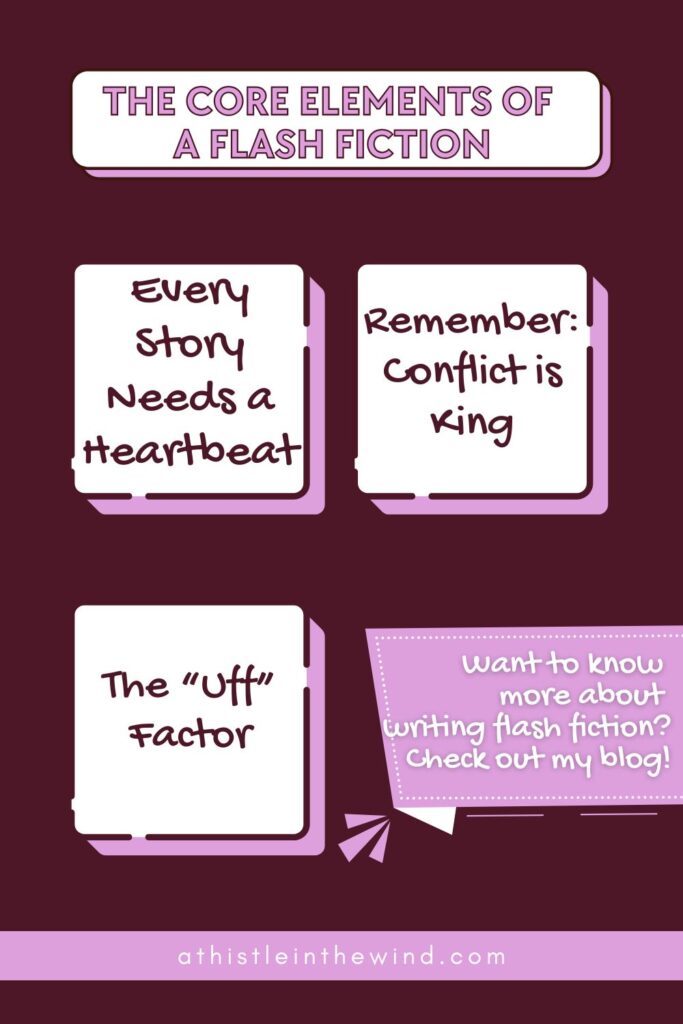
How to Craft Your Very Own Flash Fiction Piece: A Step-by-Step Guide
Okay, so now that you understand the core principles, let’s dive into the practicalities of crafting a flash fiction story.
1. Make Sure You Have a Compelling Title
In any story, a title is important. But in flash fiction, it’s even more so. Why? Because the title is the very first interaction a reader has with your story. Don’t worry if you don’t have one immediately.
Titles are incredibly important because they are almost never included in the word count, meaning they offer invaluable extra space to enhance your narrative.
A powerful title can establish the narrative voice, hint at the setting, illuminate deeper layers within your story, or present a startling image that acts as a springboard for the rest of the piece.
It can do all manner of things to enrich the reader’s experience before they’ve even read the first line. Work as diligently on your title as you do on the rest of your story. For example, a title like “On Rannoch Moor” immediately sets a place for the reader, creating an atmosphere and context before the story properly begins.
2. Hook Your Reader with Powerful Opening Lines
If you want to capture your reader immediately, try one of these techniques for your opening lines:
- Use A Curious, Compelling Narrative Voice: Introduce a voice that invites the reader into its confidence by revealing an unusual internal conflict, or one with a strange tone, idiom, or dialect.
- Include a Quirky Character: Present a character who is different from “the norm,” perhaps one who reveals a truth or a lie from the outset.
- Start with a Bold Statement: Make a dramatic, surreal, or absurd statement that compels the reader to find out more.
Remember, urgency is key from the get-go. Instead of meandering in with lengthy setups or backstory, dive straight into the conflict, or even better, begin just a moment after the conflict has started.
Your aim in these opening sentences is to orient your reader quickly: establish the place, time, narrative voice, and conflict. It’s a lot to pack in, but it can be done.
3. Navigate the Shift in the Middle Carefully
Many writers worry about “sloppy middles” in longer stories, but in flash fiction, every word counts. To keep your narrative tight and impactful, you need to think about “The Shift.”
The shift is the pivotal moment when “something” happens. The story changes in some way, and the reader gains a new understanding based on what you reveal. This shift doesn’t have to happen precisely in the middle either. It can occur in the first paragraph, two-thirds of the way in, or even as your very last line.
Where you place this shift significantly impacts the story’s pace and tone. Do you want an instant shift followed by a response? A tense build-up to a climactic shift? Or a slow, gentle burn with a subtle shift midway through?
In the middle section, keep asking yourself questions to drive the story forward:
- Has the conflict been resolved, or has it escalated?
- Has your main character started to change, or have they had a crucial realisation?
- Are they now facing a new, unexpected danger?
- How can you push the narrative forward to ensure that “something” truly happens?
4. Deliver an Unforgettable Ending
One of the most liberating aspects of flash fiction is that readers don’t always expect a neatly tied-up ending or a grand reveal. Instead, they want to be left with a feeling. This gives you incredible creative freedom.
Endings can be cyclical, bringing the story back to an earlier image or theme, or they can be implied, leaving the reader to ponder possibilities.
You might end with a striking image, either echoing your beginning or providing a stark contrast. The ending can even entirely subvert the reader’s expectations, providing a twist that recontextualises everything that came before. The most important thing is that, like that firework, your ending should never be forgettable.
Avoid clunky or clichéd “punchlines.” Instead, aim for resonance.
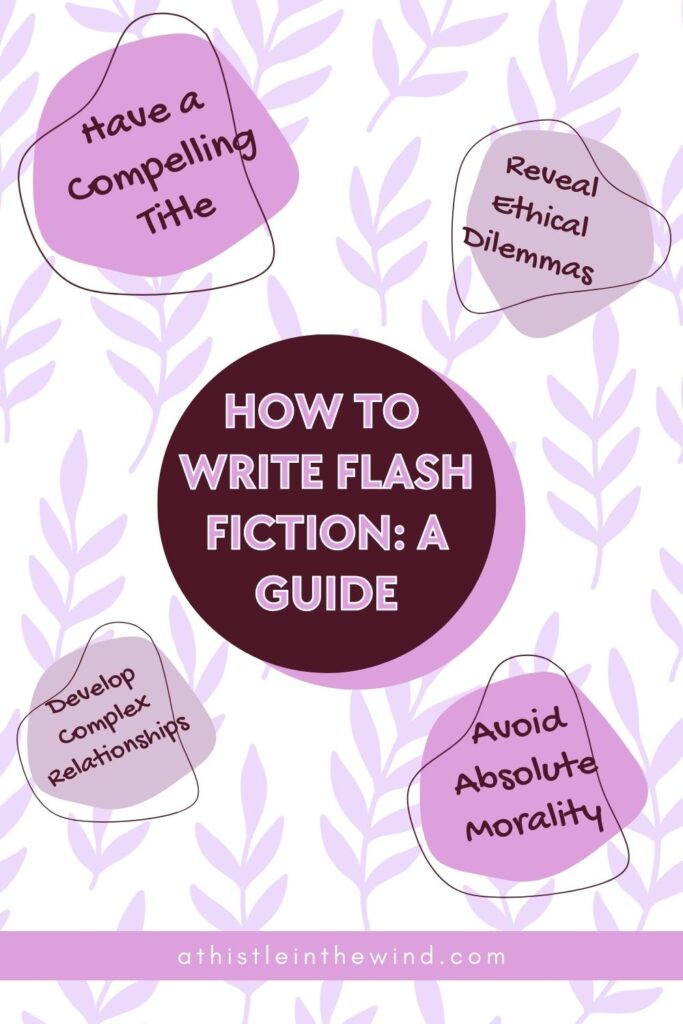
Essential Techniques to Master Flash Fiction
To achieve both brevity and complexity, flash fiction employs a toolkit of powerful literary techniques. Familiarising yourself with these will make your writing and editing process far more effective.
1. Show, Don’t Just Tell
This fundamental rule of writing is paramount in flash fiction. Instead of explicitly stating an experience or emotion, transmit it through vivid imagery and description. Don’t tell your reader the moon is shining; show them the glint of light on broken glass.
2. Focus on Scene, Not Summary
In fiction, we differentiate between a scene (a close, detailed look at an important event) and summary (a quick overview of information). Flash fiction typically contains very little summary and often only one or two crucial scenes. Each scene must be carefully chosen to propel the narrative, develop character, and build mood.
If you want to learn more about writing a scene, check out my blogs:
- How to Write the Perfect Scene: A Writer’s Guide
- 4 Signs You Should Delete a Scene: A Guide for Writers
3. The Power of Truncation
The language of flash fiction is sharp, economic, and always to-the-point. Flash writers are, by necessity, ruthless editors, constantly truncating sentences and scrapping entire paragraphs that don’t serve the core narrative. Every word must carry its weight.
4. Weave in Symbolism
Symbolism—the use of concrete objects to represent abstract concepts—is a powerful ally in flash fiction. It allows you to distill complex ideas into concise, evocative images, saving precious word count while enriching meaning.
5. Start In Media Res
Starting in media res means beginning your story in the middle of the action, rather than with a lengthy introduction. This technique is incredibly effective for flash fiction as it immediately throws the reader into the heart of the story, creating instant engagement and cutting down on the need for extensive setup. It brings suddenness and action.
6. Use Figurative Language
Flash fiction often blurs the lines between prose and poetry, borrowing heavily from poetic devices like metaphors, similes, and vivid imagery.
Figurative language allows you to communicate intense feelings and complex ideas in short bursts, creating a rich, layered experience for the reader.
7. Trust Your Reader
Because flash stories are so short, you simply don’t have the space for extensive world-building or exposition. This is where trusting your reader becomes paramount. Instead of over-explaining, rely on the reader’s intelligence and willingness to engage with implied meanings and unanswered questions. Write with brevity, focusing on the “bones” of the story, and have faith that your readers will fill in the gaps and lean into the mystery.
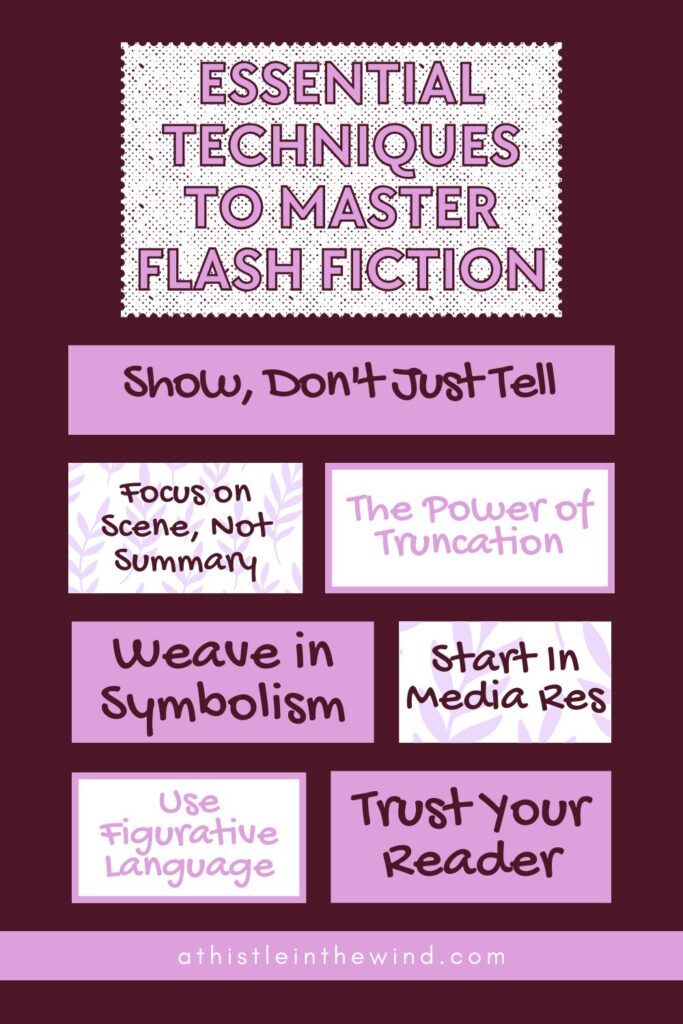
The Art of Omission: What to Write Out
In longer works, detailed descriptions and backstory are essential for immersion. In flash fiction, however, a tight word count means you must be ruthless with what you include. Here are some things you can often leave out or drastically reduce.
1. Less Interiority, More Action
Interiority refers to a character’s inner thoughts, feelings, and dreams. While some level of interiority is important for reader connection, you don’t need to convey every thought in your protagonist’s mind. Their actions and dialogue will often suffice to reveal their character and motivations. Focus on what they do and say rather than what they think for pages on end.
2. Sidestep Excessive Backstory
Backstory provides the events prior to the current story that influence a character’s decisions. While crucial in novels, in flash fiction, it can waste words. The focus should be on the main scenes and the character’s immediate actions. These elements should either explain themselves or provoke the reader’s intrigue. Don’t try to explain everything; leave some things to the reader’s imagination, explaining only when absolutely essential to the current conflict.
3. Cut Any Inaction
Action drives the story forward. Your characters make decisions, and those decisions lead to results and further actions. When your word limit is short, stick to strong nouns and verbs. We don’t need to see your character’s morning routine, what they ate for breakfast, or extended periods of deep contemplation. While these details build worlds in longer forms, in flash, embellish with detail only when it directly contributes to the action or emotion.
4. Use Active Voice
The passive voice, where the subject receives the action, tends to be wordier and less compelling. Whenever your protagonist is taking action, let your sentences also take action. Use the active voice to create punchier, more direct prose.
5. Trim the Prepositions
Prepositions are essential, but you should avoid sentence constructions that rely on them unnecessarily. For example, “This is the chair of my mother” can be more succinctly and powerfully expressed as “This is my mother’s chair.” Keep an eye out for wordy phrases that can be tightened by removing superfluous prepositions.
6. Use Strong Verbs Over Weak Adverbs
Adverbs (words that modify verbs, often ending in -ly) can add description, but often a single, strong verb can do the job more effectively and concisely. Instead of “The lion roared deeply and loudly,” consider “The lion bellowed.” Powerful, descriptive verbs will illustrate your story more vividly in fewer words.
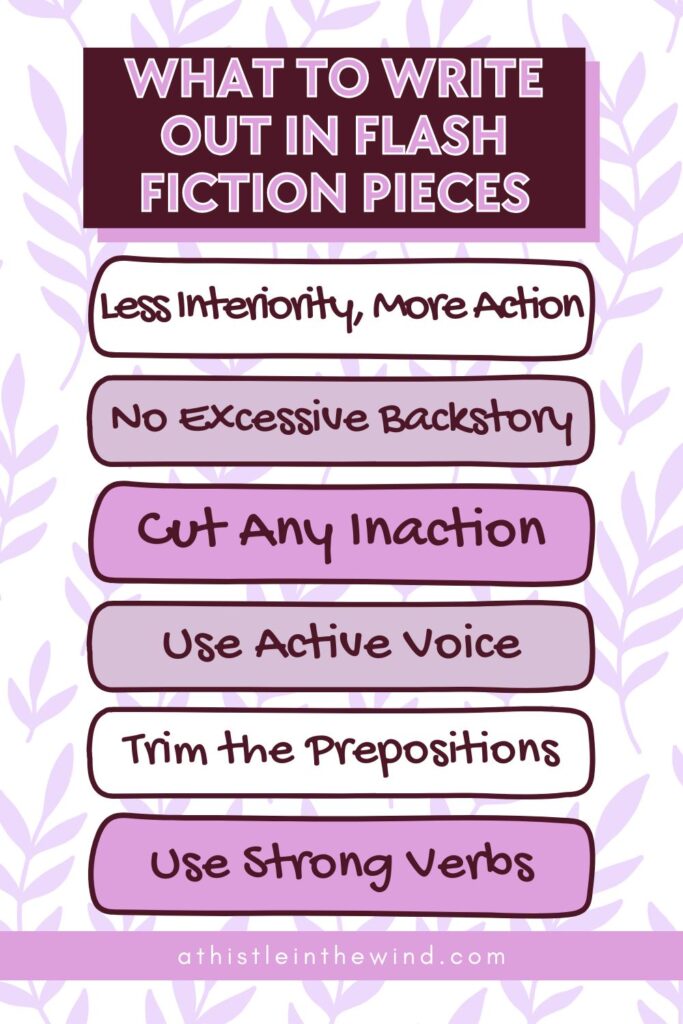
How to Get Started with Your Flash Writing Process
Okay, so now we’ve gotten all the theory behind flash fiction out of the way. Let’s look at how you can actually get started with it—especially, if you’re a new or aspiring writer.
Here are four distinct approaches that can help you craft your flash fiction stories.
1. Be A Ruthless Editor
One common approach is to write your story first as a normal, slightly longer piece, and then mercilessly cut it down. This is particularly effective if your initial draft is already somewhat close to the 1,500-word mark. Be prepared to “kill your darlings”—those beautiful sentences or paragraphs that you love but don’t strictly serve the story.
Remember, it’s far easier to add to your word count later than to stress for hours trying to trim a story that’s hundreds of words over. Consciously try to write shorter and more concisely from the outset, even in your first draft.
2. Plot First, Then Embellish
Flash stories need strong structural bones. With a “plot-first” approach, you begin by writing only the essential details of the story, completely stripping away any description or figurative language.
Once this bare-bones plot is complete, you can then selectively fill it with details, imagery, and evocative language until you hit your desired word count. This “fill in the blanks” method ensures that your story remains focused on its most important details while still feeling complete.
3. Draw from Poetry
Many literary critics observe that flash fiction often blurs the line between prose and poetry, heavily utilising poetic devices to convey plot and emotion. If you have a background or interest in poetry, consider writing the initial plot of your story in verse.
Once you have this poetic framework, you can then expand it into a prose-poem or a more traditional prose narrative, using the inherent conciseness and evocative power of poetry to your advantage.
4. Begin with the End in Mind
This approach might seem unconventional, but it can be incredibly powerful for flash fiction. Instead of starting at the beginning, decide how your story will end first.
As mentioned earlier, the final line(s) of a flash story must leave the reader thinking, offering a surprise, inverting themes, uncovering ironies, or presenting unexpected dualities.
Knowing how you want the story to conclude from your very first word will help you guide every sentence towards that powerful finish. This also aids immensely in quickly bringing the story to a close and crafting the character arc and conflict with swift, impactful strokes. Every sentence should lead to the final one, and your tone should build consistently towards that ending.
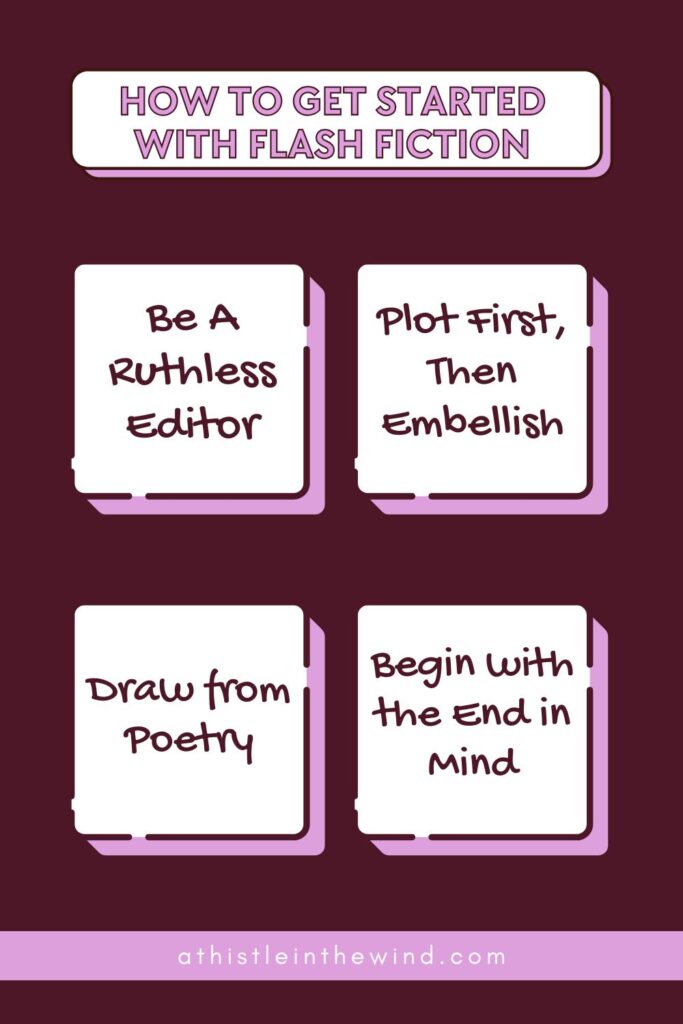
What’re You Waiting for? Start Your Flash Fiction Today!
Flash fiction can be daunting but you should definitely give it a chance! Many literary journals publish or specialise in flash fiction, offering a fantastic platform for your work. Some well-known publications include Smokelong Quarterly, Taco Bell Quarterly, and even The New Yorker.
Additionally, Flash Fiction Online and Flash Fiction Magazine are dedicated exclusively to the genre. Beyond journals, there are numerous flash writing contests available, many of which are fun to compete in and offer excellent feedback and community engagement. So, what’re you waiting for? Start writing:D

3 Comments
Bart Faubert
Geeat tips all around!
Sherrie Wells
another great piece!
drover sointeru
I saw a lot of website but I think this one has something special in it in it